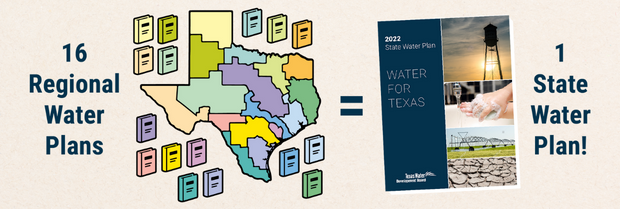Planning for Drought

Ensuring adequate and affordable water supplies for all Texans to withstand future droughts requires both advance planning and implementation prior to the onset of drought. The Texas Water Development Board (TWDB) is the state's lead water planning agency and is statutorily responsible for administering the regional water planning process and preparing and adopting the state water plan every five years. Each new state water plan, which considers a 50-year horizon, must support preparation for and response to drought conditions and must reflect and respond to changes in population, water supplies, technological improvements, the socioeconomic impacts of not addressing water supply needs during drought, project viability, and state policy.
Since 1997, water planning in Texas has been based on local involvement from 16 regional water planning areas. During each five-year planning cycle, regional water planning groups, supported by the TWDB, evaluate population projections, water demand projections under drought conditions, and existing water supplies available during drought. Each planning group then identifies potential water shortages under drought of record conditions (water needs), recommends water management strategies (with cost estimates) to address those potential shortages, and determines the socioeconomic impacts of not addressing the identified water needs.
The 2022 State Water Plan contains a chapter on drought and drought response in Texas that presents comprehensive information on
- measuring drought status and severity;
- historical and potential new droughts of record;
- statewide, regional, and local drought planning and response;
- regional drought recommendations; and
- drought-related uncertainty.
Much of the content in the state water plan's drought chapter is gleaned from information provided by regional water planning groups. These groups are required to compile and present regional drought information and resources in Chapter 7 of their regional water plans, including information on
- droughts of record in the planning area,
- current drought preparations and drought response triggers and actions,
- existing and potential emergency interconnects,
- emergency responses to local drought conditions or loss of municipal supply,
- drought management water management strategies,
- region-specific model drought contingency plans, and
- drought-related considerations and recommendations.
Also, understanding the projected water needs of water user groups as a share of total water demand provides an indicator of the severity of a water user group's needs during a recurrence of drought. This table, which was developed to accompany the 2022 State Water Plan, shows these needs as a percent by water user group. The larger the percent of an entity's total demand that needs represent, the more severe of a potential shortage they may face. Bolded text in the table indicates that the needs identified are fully met if the strategies recommended for the entity are implemented.
For more data and information from the 2022 State Water Plan, visit the 2022 Interactive State Water Plan.
In addition to planning for drought via the regional water supply planning process, another tool water providers can use is a drought contingency plan. Drought contingency plans are a strategy or combination of strategies that a water supplier develops and implements to monitor and respond to a drought or other temporary water shortage that can severely disrupt the supply of water to customers. All retail public water suppliers, wholesale water suppliers, and irrigation districts are required to have a drought contingency plan. Certain entities are required to submit them to the Texas Commission on Environmental Quality.
What Is the “Drought of Record”?
The drought of record is a period when historical records indicate that natural hydrological conditions provided the least amount of water supply.
History demonstrates that extended droughts are natural phenomena in Texas, often punctuated by times of flood. The drought of the 1950s is the most significant drought recorded in Texas' history (dating back to 1895) in terms of geographic extent, duration, and intensity. As measured by the Palmer Drought Severity Index, the drought of record lasted 77 months, from October 1950 to February 1957 (NOAA, 2020). Based on the same index, the 2010-2014 drought ranks as the second worst and the second-longest statewide drought, lasting 51 months, from August 2010 to October 2014. Occurring within the 2010-2014 drought, 2011 ranks as the worst one-year drought on record in Texas.
Texas uses the 1950s drought of record as a fundamental benchmark for statewide water planning, with the intention that preparing for severe drought conditions that have already occurred will help the state better respond to future droughts. That said, more severe, regional, or basin-specific droughts of record are also considered by regional water planning groups as updated hydrologic and water use information is incorporated into both the relevant datasets and surface water availability models.
For more detailed information on the “drought of record,” refer to this explanatory resource.